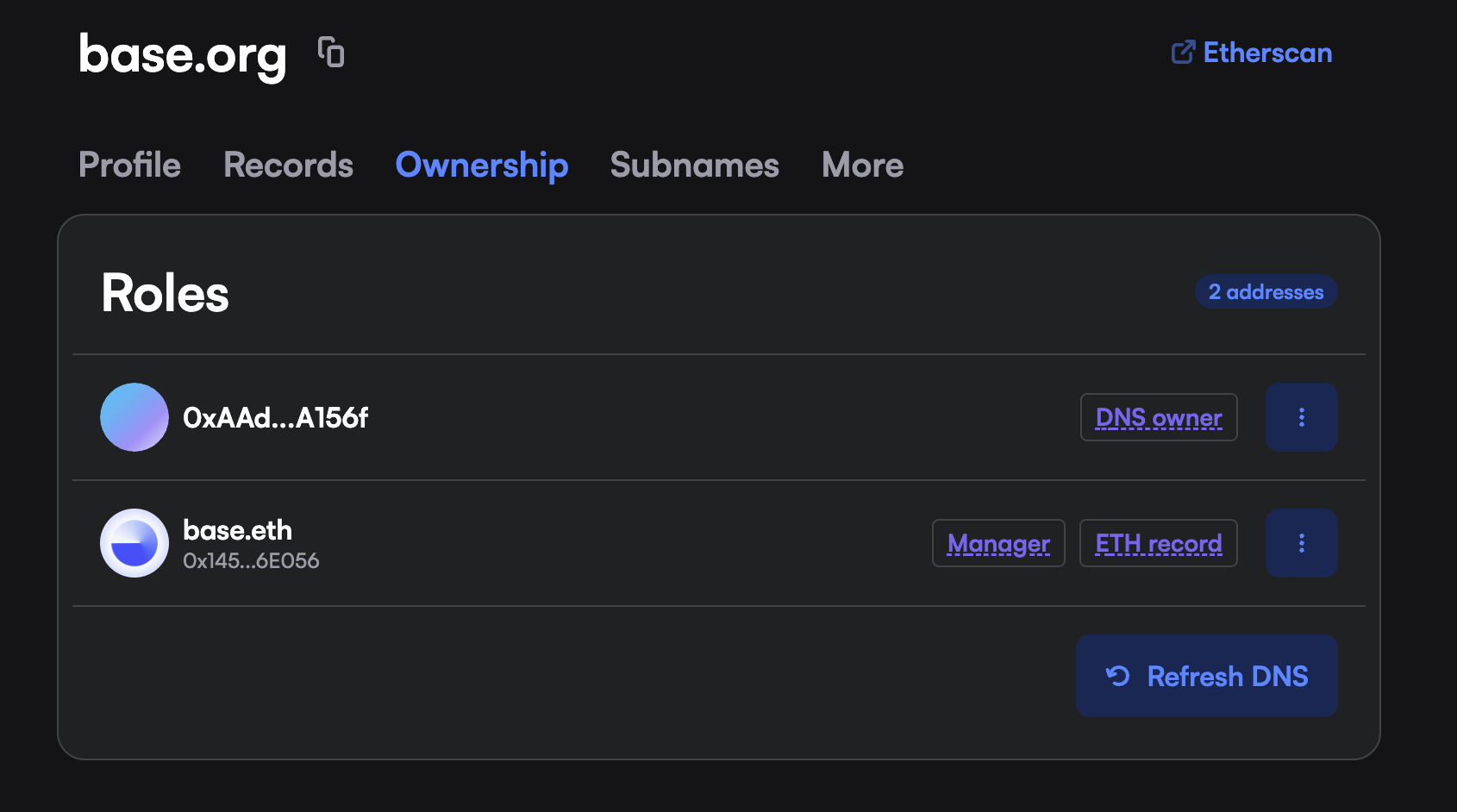DAO/Governance Best Practices
DAO Category and Contract Subcategories
DAOs are an essential part of web3 infrastructure. DAO governance contracts can range from simple standalone Governor/DAO contracts to complex multi-layered architectures like Lido's dual governance system or unique implementations like MakerDAO's governance module.
Most DAOs are built upon either OpenZeppelin's Governance framework or Aragon's DAO framework:
OpenZeppelin-based DAOs: Uniswap, ENS, The Graph, Gitcoin, Nouns, etc. Aragon-based DAOs: Lido, Polygon, Taiko, Puffer, Boundless, Curve Finance, etc.
The majority of DAOs follow a governance model similar to Uniswap's architecture (based on OpenZeppelin framework):
- Token - UNI Address
- Governor - GovernorBravo
- Timelock - Timelock Controller
DAO Contract Naming and ENS Onboarding Process
Step 1: Register new ENS Domain on ENS App
Choose one of these naming patterns:
<org>.eth(if available)<org>dao.eth<org>-dao.eth
Example: uniswap.eth, ensdao.eth, nouns-dao.eth
Step 2: Create DAO Subdomain (if needed)
If "dao" is not included in your 2LD name, create a subdomain that will act as the parent domain for DAO contracts:
dao.<org>.eth
Example: dao.uniswap.eth
Step 3: Add DAO Metadata
Add DAO metadata to your main DAO ENS name/subname according to EIP-4824 standard.
- If your DAO's ENS name is
<org>dao.ethor<org>-dao.eththen directly store DAO metadata under the main name's text records. Example: ENS DAO metadata - If your DAO's ENS name is
<org>.ethand you created a subnamedao.<org>.eththen store DAO metadata under subname's text records.
Step 4: Create Contract Subdomains
Name each contract under your DAO domain with descriptive subnames following the patterns below.
Wherever <yourdao> is mentioned, treat it as <org>dao, <org>-dao or dao.<org>
Please refer to the Appendix for additional information on these contracts.
| Contract name | Description | Naming convention | Where to name |
|---|---|---|---|
| Governor (core) | Based on Openzepplin Governance framework or Aargon's DAO framework | governor.<yourdao>.eth | Enscribe / Raw Tx builder |
| Governance Token | Token for voting purpose | <token-symbol>.<youdao>.eth or token.<yourdao>.eth | Enscribe / Raw Tx builder |
| Timelock controller | Contract that may hold assets and enforce a delay before executing | timelock.<yourdao>.eth, executor.<yourdao>.eth | Enscribe / Raw Tx builder |
| Main Wallet | DAO treasury / operations multisig | wallet.<yourdao>.eth, operations.<yourdao>.eth | ENS App |
| Treasury | DAO treasury where funds are stored | treasury.<yourdao>.eth | Enscribe / Raw Tx builder |
| Voting Contract | Based on Aargon's voting plugins or OZ's Voting Modules | voting.<yourdao>.eth | Enscribe / Raw Tx builder |
| Other wallets (smart wallets/EOAs) | Guardians, Endowment, Admin, Emergency, Veto, Security council | <role>.<yourdao>.eth | ENS App |
| Other access/permission/controller/misc Contracts | Delegation contract, Access/permission manager, Controllers, Other Aragon or OZ based contracts | <contract-name>.<yourdao>.eth | Enscribe / ENS App / Raw Tx builder |
Step 5: Add Contract Metadata
Add detailed metadata to each contract name according to ENSIP: Contract Metadata Standard and Text Records (draft standard).
Example - governor.ensdao.eth metadata →
name: ENS DAO Governor
description: ENS DAO's Governance contract to create and execute proposals
Avatar: ipfs://qwerty…
url: https://ensdao.org/
category: governance
license: MIT
docs: https://docs.ens.domains/dao/
audits: []
proxy (optional):
Step 6: Claim DNS Domain (Optional but Recommended)
Claiming your DNS domain on ENS establishes trust and verifies that the ENS name belongs to the legitimate organization by creating a verifiable link between your traditional web presence and your DAO's ENS identity.
This process involves visiting the ENS Manager App, searching for your DNS domain (e.g., <yourorg>.com), and following the verification process.
For detailed instructions, refer to the official DNS on ENS documentation which provides step-by-step guidance on the claiming process.
Real-world example - Base (base.org linked to base.eth as manager) demonstrates how an organization should link their traditional domain with their ENS presence for enhanced credibility and trust within the web3 ecosystem.

Appendix
Major DAO Contract Types and Examples
1. Core Governor/DAO Contract
Description: The primary governance contract that handles proposal creation, voting, and execution. This is the heart of the DAO's decision-making process.
Naming Convention:
governor.<yourdao>.eth
Example DAOs: Uniswap, ENS
2. Governance Token
Description: The ERC-20 token that represents voting power in the DAO. Token holders use these tokens to participate in governance decisions.
Naming Convention:
token.<yourdao>.eth<token-symbol>.<yourdao>.eth
Example DAOs: Uniswap, ENS
3. Timelock Controller
Description: A contract that introduces a delay between proposal approval and execution, providing security by allowing token holders time to react to malicious proposals.
Naming Convention:
timelock.<yourdao>.ethexecutor.<yourdao>.eth
Example DAOs: Uniswap, Arbitrum
4. Treasury
Description: The contract or multi-signature wallet that holds and manages the DAO's funds. May include multiple treasuries for different purposes (grants, operations, etc.).
Naming Convention:
treasury.<yourdao>.eth
Example DAOs: Arbitrum, Gitcoin
5. Voting Contract
Description: Specialized contracts that handle the voting mechanism, vote counting, and delegation. In OpenZeppelin Governor, this is often integrated into the main Governor contract as voting modules. In Aragon this may be based on voting plugins.
Naming Convention:
voting.<yourdao>.eth
Example DAOs: Lido
6. Main DAO Wallet/Multisig
Description: The primary operational wallet used for DAOs operational activities. Often a multi-signature wallet controlled by core team members or elected delegates.
Naming Convention:
operations.<yourdao>.ethwallet.<yourdao>.eth
Example DAOs: ENS, zk-nation